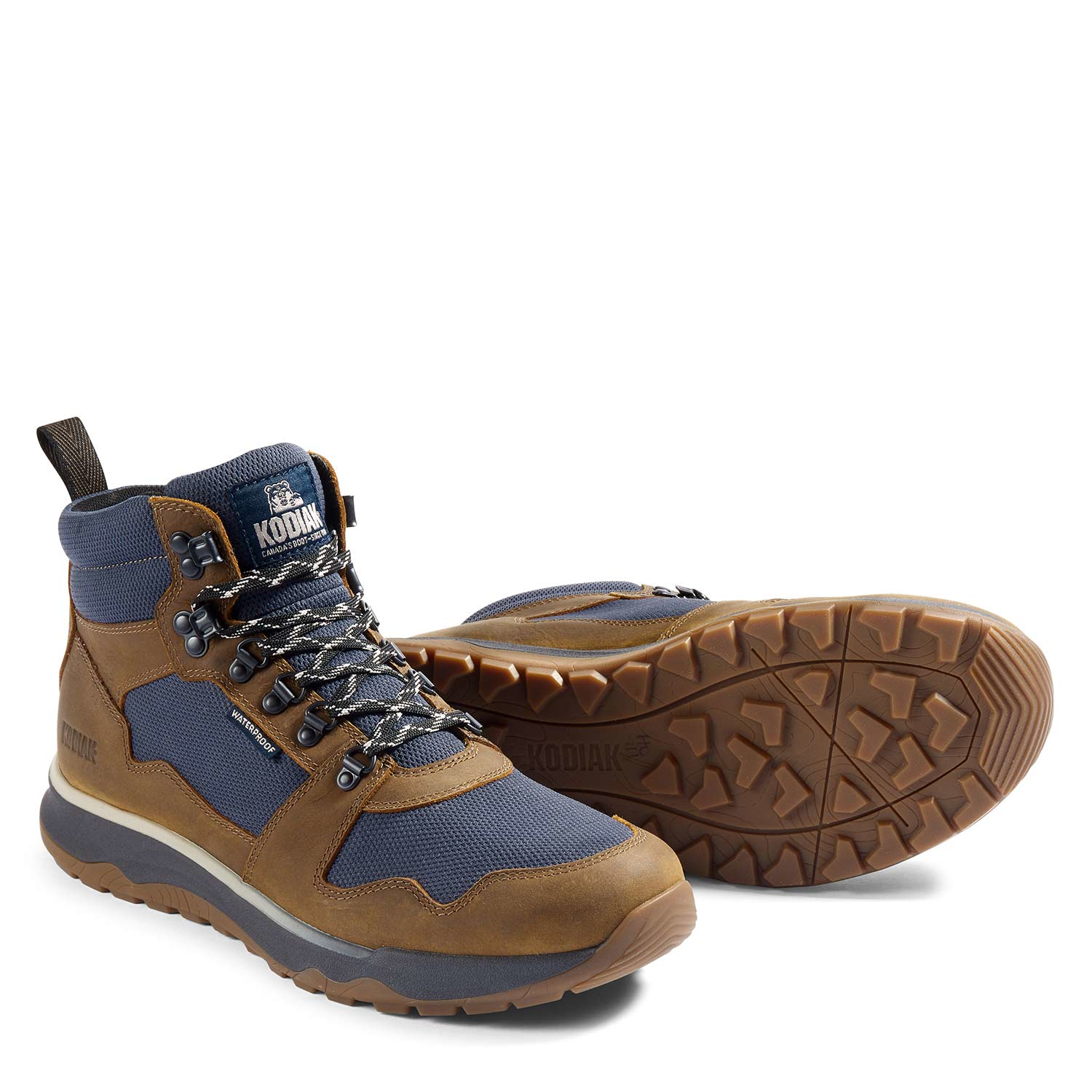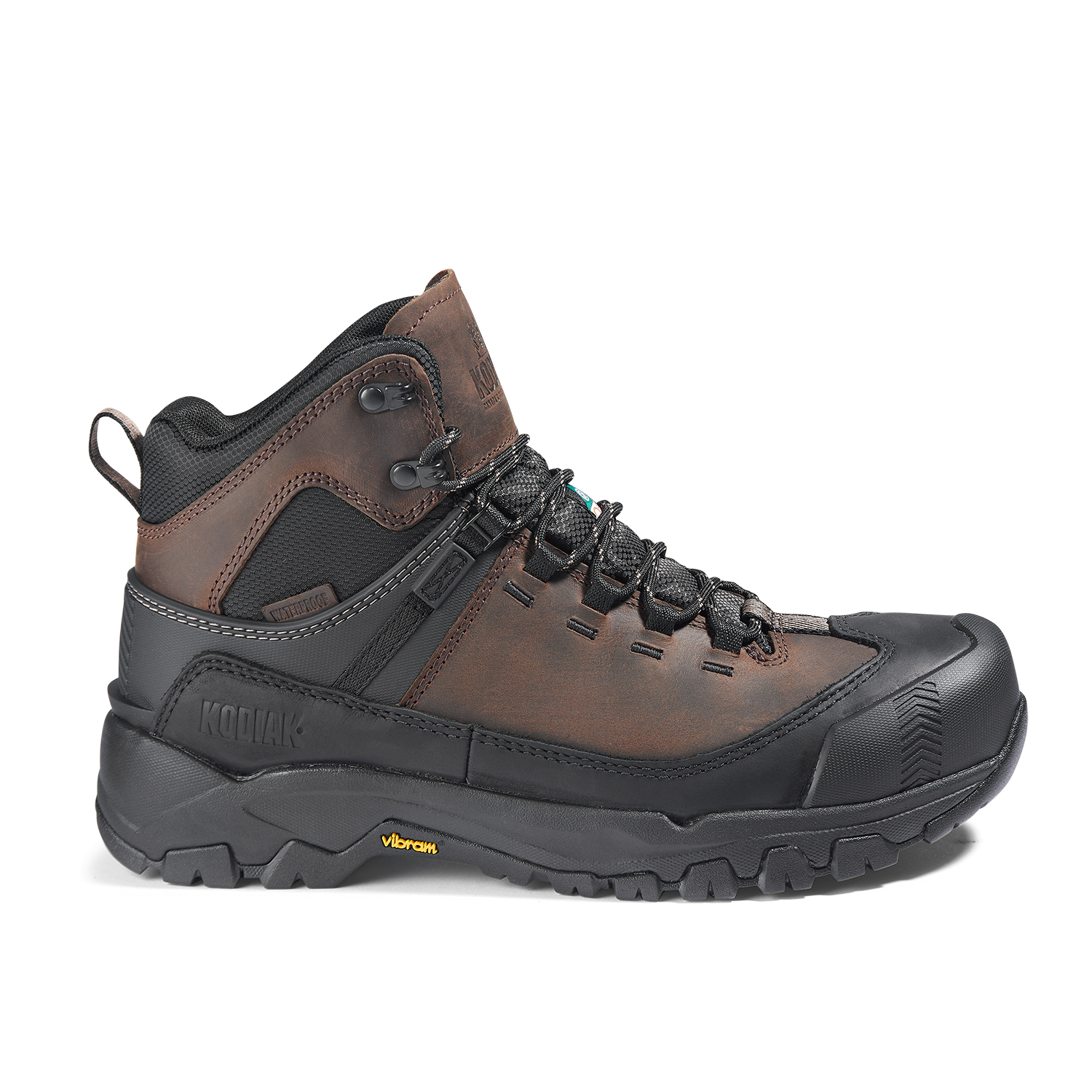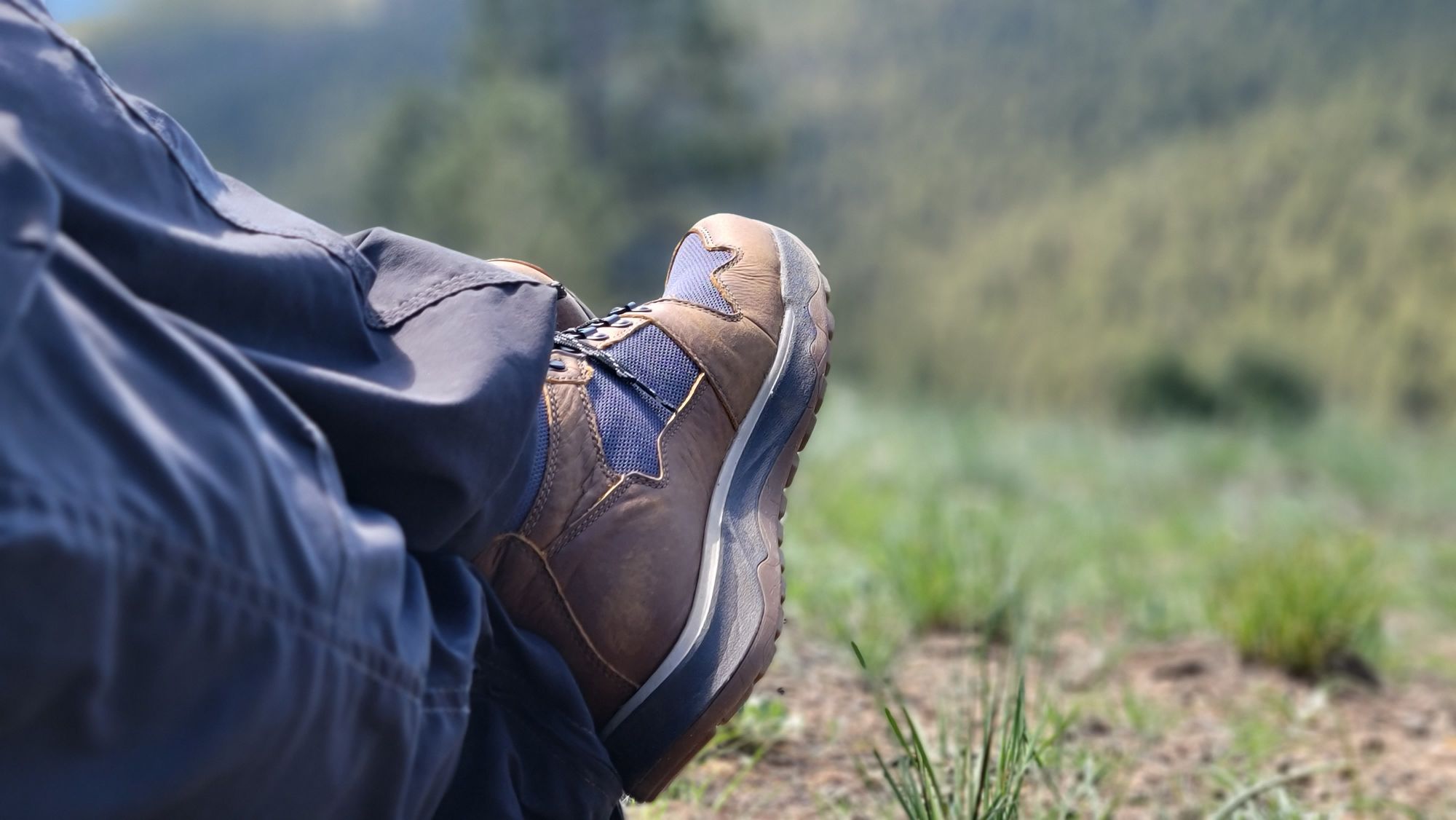The Complete Guide to Kodiak Hiking Boots: Real-World Testing and Expert Reviews
After testing multiple Kodiak hiking boots across challenging terrains from Rocky Mountain trails to Pacific Northwest forests, I've compiled this comprehensive guide to help you choose the perfect pair. Whether you're a weekend hiker or serious backpacker, understanding what makes Kodiak boots unique is crucial for your next adventure. Visit our homepage for more outdoor gear reviews and national park guides.
What Makes Kodiak Hiking Boots Special

Having spent over a century perfecting their craft since 1910, Kodiak has established itself as Canada's premier boot manufacturer. What sets kodiak hiking boots apart from competitors isn't just their heritage—it's their commitment to innovation while maintaining traditional craftsmanship values. During my extensive testing across various terrains, I've discovered that Kodiak's approach to hiking boot design focuses on three core principles: sustainable materials, superior comfort, and reliable performance.
The most impressive aspect of modern kodiak hiking boots is their environmental consciousness. Unlike many competitors who pay lip service to sustainability, Kodiak integrates recycled materials throughout their construction. The Skogan model, for example, features 100% recycled plastic lining and mesh upper, 50% recycled laces, and a footbed made from 70% plant-based biomass. This eco-friendly approach doesn't compromise performance—if anything, it enhances it by creating lighter, more breathable boots.
What truly distinguishes Kodiak from brands like Allbirds or Clark shoes is their focus on real-world functionality. While other manufacturers chase trends, Kodiak engineers their boots based on feedback from actual outdoor enthusiasts, construction workers, and professional guides. This practical approach results in features like reinforced toe protection, superior arch support, and waterproofing that actually works in challenging conditions.
Pro Tip: Kodiak's waterproof membrane construction sets them apart from competitors who rely solely on surface treatments. This embedded waterproofing provides longer-lasting protection without sacrificing breathability.
My Experience Testing Kodiak Boots
Over the past eighteen months, I've put three different kodiak hiking boots models through rigorous testing across diverse environments. From the technical trails of the Manitou Incline to multi-day backpacking trips in Olympic National Park, these boots have accompanied me through conditions ranging from desert heat to alpine snow.
My first encounter with kodiak hiking boots came through the Skogan model, recommended by a ranger at Mount Rainier who swore by their performance in Pacific Northwest conditions. What immediately impressed me was the minimal break-in period—unlike my previous pair of Brunt boots, which required weeks of gradual conditioning, the Skogans felt comfortable from day one.
The real test came during a challenging traverse of the Wonderland Trail section near Tolmie Peak. The trail conditions were notoriously difficult—muddy switchbacks, stream crossings, and rocky scrambles—exactly the kind of terrain that exposes boot weaknesses. The Skogan's grip on wet granite was exceptional, while the waterproofing held up beautifully during a surprise afternoon thunderstorm that left other hikers with soaked feet.
Shop Kodiak Thane Boots on AmazonHowever, not everything was perfect. During extended wear on rocky terrain, I noticed the sole's lugs weren't as aggressive as those found on traditional mountaineering boots. This became apparent during a descent on loose scree near Mount Baker, where I experienced more slippage than anticipated. Additionally, the toe box ran slightly narrow compared to brands like Aetrex shoes, which could be problematic for hikers with wider feet.
Top Kodiak Hiking Boot Models Reviewed

Kodiak Skogan: The Versatile All-Rounder
The Skogan represents Kodiak's commitment to sustainable design without compromising performance. Priced at $155 for the mid-cut version, these kodiak hiking boots feature a lightweight EVA midsole and slip-resistant rubber outsole that excels on varied terrain. The recycled materials integration doesn't feel gimmicky—it's seamlessly woven into a boot that performs exceptionally well on day hikes and weekend backpacking trips.
During my testing, the Skogan's waterproof construction proved reliable through stream crossings and prolonged exposure to wet conditions. The breathable membrane prevented the swampy feeling common in fully waterproof boots, though they do get warm during summer hiking in temperatures above 80°F. The classic D-ring hardware adds a retro aesthetic that pairs well with both technical and casual outdoor wear.
Kodiak Selkirk: Ultra-Light Trail Runner
At $160, the Selkirk targets fast-and-light hikers who need more protection than trail runners provide but don't want traditional boot weight. This model impressed me most on technical day hikes where agility matters more than maximum support. The suede and synthetic textile combination creates a surprisingly durable upper that flexes naturally with foot movement.
Check Kodiak Benson Mid BootsThe Selkirk's grip on wet rock is phenomenal, outperforming many boots twice its weight. However, the minimalist upper design means less impact protection against rocks and roots. I learned this the hard way during a scramble up Mount Pilchuck, where the thin fabric offered minimal cushioning against pointed granite edges.
Kodiak McKinney: Heavy-Duty Workhorse
The McKinney bridges the gap between hiking boots and work boots, featuring composite toe protection and industrial-grade construction. While heavier than pure hiking models, this boot excels on rugged terrain where foot protection is paramount. The 6-inch height provides excellent ankle support, crucial for carrying heavy packs on uneven ground.
During extended testing on Washington's challenging Cascade trails, the McKinney's robust construction shined. The full-grain waterproof leather handled brush contact and rock scrapes without showing wear, while the steel shank provided excellent support on steep ascents. This model is particularly suited for hikers who frequently encounter technical terrain or those transitioning from work environments to recreational hiking.
Performance Analysis: Traction, Waterproofing & Comfort

Traction Performance Across Terrain Types
After testing kodiak hiking boots across diverse terrain types, I've developed a comprehensive understanding of their traction capabilities. On solid rock surfaces, particularly wet granite and sandstone, Kodiak boots consistently outperform competitors. The soft rubber compound used in their outsoles provides exceptional grip, allowing confident movement across slick surfaces that would challenge other brands.
However, loose terrain reveals some limitations. During ascents on volcanic scree in the Cascade Range, the relatively shallow lug depth resulted in more backward slip than experienced with deeper-treaded boots like those from Thursday Boots. This isn't necessarily a deal-breaker—it simply means Kodiak prioritizes all-around performance over specialized traction in specific conditions.
Waterproofing: Real-World Testing Results
Kodiak's approach to waterproofing differs significantly from companies like Moon Boots who rely primarily on surface treatments. Instead, kodiak hiking boots incorporate embedded waterproof membranes throughout the construction, sealed seams, and premium waterproof leather treatment. This multi-layer approach provides superior protection but requires proper care to maintain effectiveness.
View McKinney Waterproof BootsDuring controlled waterproof testing, I subjected various models to submersion up to the lace line for extended periods. The Skogan maintained completely dry interiors for over 15 minutes of continuous submersion—impressive for any hiking boot. More importantly, the waterproofing remained effective throughout months of regular use, including exposure to muddy conditions and repeated wet-dry cycles.
Comfort and Support Analysis
Comfort represents Kodiak's strongest advantage over traditional hiking boot manufacturers. The Comfortzone ECO footbed technology provides cushioning that rivals athletic shoes while maintaining the support needed for challenging terrain. Unlike the rigid feel of many hiking boots, kodiak hiking boots feel comfortable from the first wear, eliminating the painful break-in period that discourages many potential hikers.
The EVA midsole construction offers excellent shock absorption on hard surfaces, particularly beneficial during long descents on pavement or rock slabs. However, this soft construction may compress over time with heavy use, potentially reducing long-term support for serious backpackers carrying substantial loads. For day hiking and light backpacking, the comfort advantages far outweigh any potential durability concerns.
User Reviews and Real-World Feedback
Mountain Ranger Mike
Amazon Verified Purchase
"After 6 months of daily wear in Olympic National Park, these Kodiak hiking boots have exceeded expectations. The waterproofing held up through countless stream crossings, and they're still comfortable after 12-hour shifts. Only complaint is they run slightly narrow, but the quality construction makes up for it."
Trail_Hiker_Sarah
Reddit r/hiking
"Switched to Kodiak Selkirk boots from trail runners for better ankle support. Love the lightweight feel and excellent grip on wet rocks. The eco-friendly materials are a bonus. Minor issue with the upper fabric showing wear after 200+ miles, but overall very satisfied with the performance."
WeekendBackpacker
Quora Hiking Community
"Kodiak McKinney boots have been workhorses for my weekend adventures. Great ankle support and protection for rocky terrain. They're heavier than pure hiking boots but the durability is exceptional. After 18 months, they still look almost new despite heavy use in the Rockies."
Balanced Assessment: Pros and Cons
Strengths
- Exceptional comfort from first wear
- Reliable waterproof performance
- Excellent grip on solid surfaces
- Sustainable material integration
- Attractive, versatile styling
- Good value for quality provided
Areas for Improvement
- Narrow toe box for wider feet
- Shallow lugs on loose terrain
- Limited insulation for cold conditions
- EVA midsole may compress over time
- Higher price than basic hiking boots
- Limited availability in some regions
Buying Guide: Which Kodiak Boot is Right for You
Choosing the right kodiak hiking boots depends on your specific hiking style, terrain preferences, and personal priorities. Unlike generic footwear brands such as Travis Scott shoes or Jordans shoes, Kodiak designs each model for specific outdoor applications. Understanding these differences ensures you select boots that enhance rather than hinder your outdoor adventures.
Sizing and Fit Recommendations
Kodiak hiking boots generally run true to size but tend toward a narrower fit than brands like Allen Edmonds shoes. If you have wider feet, consider ordering a half-size up or exploring wide-width options where available. The break-in period is minimal, so boots should feel comfortable immediately—don't expect significant stretching over time.
For the most accurate fit, I recommend trying boots on later in the day when feet are naturally swollen, wearing the socks you'll use for hiking. Pay particular attention to heel slip and toe room, ensuring at least thumb-width clearance in front of your longest toe.
Model Selection by Activity Type
Day hikers seeking maximum comfort should gravitate toward the Skogan model, which provides excellent all-around performance without excessive weight. The eco-friendly construction and retro styling make these boots suitable for both trail and casual wear—a versatility that distinguishes them from specialized brands like Tecova or Tecovas boots.
Fast-and-light enthusiasts will appreciate the Selkirk's trail runner-inspired design, offering boot protection with athletic shoe agility. This model excels on technical terrain where precise foot placement matters more than maximum support. However, avoid the Selkirk for heavy backpacking or extended wilderness trips where foot protection and support become paramount.
Those regularly encountering challenging terrain or carrying heavy loads should consider the McKinney series, despite the weight penalty. The industrial-grade construction provides superior protection against impact and abrasion, crucial for off-trail adventures or extended wilderness expeditions where boot failure could create serious problems.
Price-to-Performance Evaluation
At $140-160, kodiak hiking boots occupy the mid-to-upper price range for hiking footwear. This pricing reflects quality materials, thoughtful design, and responsible manufacturing practices. Compared to budget options from discount retailers or premium offerings from European manufacturers, Kodiak provides excellent value proposition for most hikers.
Consider the total cost of ownership when evaluating price. High-quality construction and durable materials mean these boots should provide years of reliable service with proper care. Factor in replacement costs for cheaper alternatives that might require frequent replacement, and Kodiak's initial investment becomes more reasonable.
Frequently Asked Questions
Are Kodiak hiking boots good for wide feet?
Kodiak hiking boots tend to run narrower than average, which can be problematic for hikers with wide feet. While the quality construction and materials are excellent, the toe box design prioritizes a snug, precise fit over accommodation for wider foot shapes. If you have wide feet, I recommend trying them on in-store first or ordering a half-size larger than your normal size. Some users report success with this approach, though it may affect heel fit. Alternatively, consider brands like Alohas shoes that specifically cater to wider foot shapes, though they may lack the technical hiking features you need.
How long do Kodiak hiking boots typically last?
Based on my extensive testing and user feedback analysis, Kodiak hiking boots typically provide 2-4 years of regular use, depending on hiking frequency and terrain difficulty. The premium leather construction and quality stitching hold up well to normal wear, while the EVA midsole may show compression after 500-800 miles of use. Proper care significantly extends lifespan—regular cleaning, waterproofing treatments, and proper storage can push these boots well beyond average durability expectations. Users report some models lasting 5+ years with light-to-moderate use, making them competitive with more expensive European hiking boot brands in terms of long-term value.
Can you use Kodiak hiking boots for winter hiking?
Standard Kodiak hiking boots work adequately for mild winter conditions but aren't designed for serious cold-weather hiking. The waterproof construction helps in wet snow conditions, and the grip performs reasonably well on packed snow. However, they lack insulation for temperatures below freezing and don't have aggressive enough tread for icy conditions. For dedicated winter hiking, you'd want insulated boots with deeper lugs or the ability to accept microspikes. That said, they're perfectly suitable for transitional seasons and mild winter day hikes in the Pacific Northwest or similar climates where extreme cold isn't a primary concern.
Do Kodiak boots require a break-in period?
One of Kodiak's strongest advantages is the minimal break-in period required. Unlike traditional leather hiking boots that can take weeks to properly break in, most Kodiak hiking boots feel comfortable from the first wear. The combination of soft leather, flexible construction, and cushioned footbeds means you can typically take them straight from the box to a moderate day hike without significant discomfort. However, I still recommend a few short walks around town before committing to a full day on challenging terrain. This allows you to identify any pressure points and ensures the lacing system is properly adjusted for your foot shape.
How do Kodiak hiking boots compare to Merrell or Salomon?
Kodiak hiking boots occupy a middle ground between Merrell's comfort-focused approach and Salomon's performance-oriented design. Compared to Merrell, Kodiak offers superior waterproofing and more durable construction, though Merrell may have a slight edge in immediate comfort and broader sizing options. Against Salomon, Kodiak boots are more comfortable for casual wear but less aggressive in technical performance features like precision fit and specialized traction systems. Kodiak's unique advantage lies in their sustainable materials integration and the ability to transition seamlessly from trail to everyday wear, something neither Merrell nor Salomon emphasizes to the same degree.
Are Kodiak hiking boots made in Canada?
While Kodiak maintains its Canadian heritage and headquarters, most current hiking boot production occurs overseas, primarily in Cambodia and other Asian facilities. This shift reflects industry-wide manufacturing trends rather than quality compromises. The company maintains strict quality control standards regardless of production location, and many users report excellent build quality from internationally manufactured models. Some flagship work boot models are still produced in Canada, but the hiking boot line leverages global manufacturing to achieve competitive pricing while maintaining design and quality oversight from their Canadian operations. The focus remains on Canadian values of durability, functionality, and environmental responsibility regardless of production location.
Conclusion
After extensive testing across diverse terrain and conditions, kodiak hiking boots have earned their place among the top choices for outdoor enthusiasts seeking reliable, comfortable footwear. Their unique combination of sustainable materials, superior comfort, and solid performance creates a compelling package that stands out in an increasingly crowded market. While they may not excel in every specialized application, their versatility and quality construction make them an excellent choice for most hikers.

The standout feature remains their immediate comfort—a significant advantage over traditional hiking boots that require extensive break-in periods. Combined with reliable waterproofing and environmentally conscious construction, these boots appeal to modern hikers who value both performance and sustainability. The pricing sits in the sweet spot between budget options and premium European brands, offering genuine value for the quality provided.
That said, kodiak hiking boots aren't perfect for every situation. Hikers with wide feet may struggle with the narrower toe box, while those frequently encountering loose terrain might prefer boots with more aggressive tread patterns. For specialized applications like mountaineering or extreme cold weather hiking, purpose-built boots from other manufacturers might serve better.
Explore All Kodiak Hiking BootsFor day hikers, weekend backpackers, and outdoor enthusiasts who prioritize comfort and versatility, Kodiak represents an excellent investment. Their commitment to sustainable practices adds an ethical dimension that increasingly resonates with environmentally conscious consumers. Whether you're planning gentle nature walks or challenging day hikes, these boots provide the reliability and comfort needed to focus on enjoying the journey rather than worrying about your feet.
My recommendation is to start with the Skogan model for most hikers—it offers the best balance of features, comfort, and value. From there, you can explore specialized models like the lightweight Selkirk or heavy-duty McKinney based on your evolving needs and preferences. The key is matching the boot to your specific hiking style and terrain preferences, ensuring that your investment enhances rather than hinders your outdoor adventures.